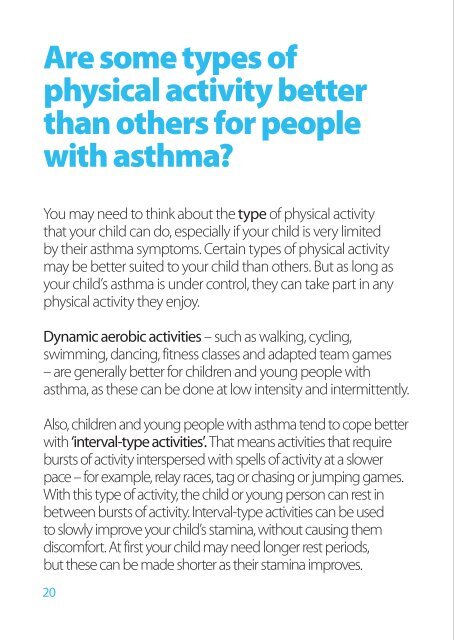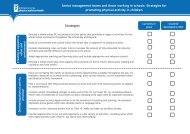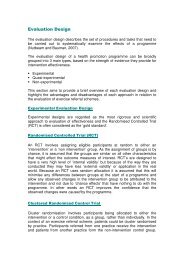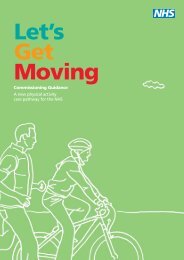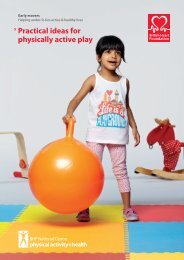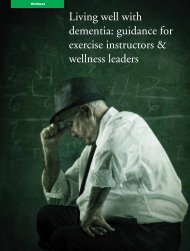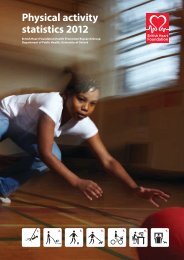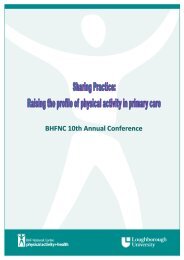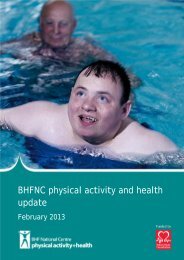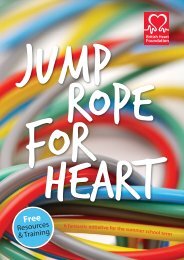Physical activity – What if my child has asthma? - BHF National ...
Physical activity – What if my child has asthma? - BHF National ...
Physical activity – What if my child has asthma? - BHF National ...
You also want an ePaper? Increase the reach of your titles
YUMPU automatically turns print PDFs into web optimized ePapers that Google loves.
Are some types ofphysical <strong>activity</strong> betterthan others for peoplewith <strong>asthma</strong>?You may need to think about the type of physical <strong>activity</strong>that your <strong>child</strong> can do, especially <strong>if</strong> your <strong>child</strong> is very limitedby their <strong>asthma</strong> symptoms. Certain types of physical <strong>activity</strong>may be better suited to your <strong>child</strong> than others. But as long asyour <strong>child</strong>’s <strong>asthma</strong> is under control, they can take part in anyphysical <strong>activity</strong> they enjoy.Dynamic aerobic activities – such as walking, cycling,swimming, dancing, fitness classes and adapted team games– are generally better for <strong>child</strong>ren and young people wit<strong>has</strong>thma, as these can be done at low intensity and intermittently.Also, <strong>child</strong>ren and young people with <strong>asthma</strong> tend to cope betterwith ‘interval-type activities’. That means activities that requirebursts of <strong>activity</strong> interspersed with spells of <strong>activity</strong> at a slowerpace – for example, relay races, tag or c<strong>has</strong>ing or jumping games.With this type of <strong>activity</strong>, the <strong>child</strong> or young person can rest inbetween bursts of <strong>activity</strong>. Interval-type activities can be usedto slowly improve your <strong>child</strong>’s stamina, without causing themdiscomfort. At first your <strong>child</strong> may need longer rest periods,but these can be made shorter as their stamina improves.Activities with rest periods should still involve somemovement, but at a slower pace. This is known as ‘activerest’. Complete rest in between bursts of <strong>activity</strong> is notrecommended.Indoor swimmingRecreational indoor swimming is an excellent <strong>activity</strong> for<strong>child</strong>ren and young people with <strong>asthma</strong>, as they can doit at their own pace. Also, the warm, humid air in theswimming pool is less likely to trigger your <strong>child</strong>’s <strong>asthma</strong>symptoms. However, your <strong>child</strong> should take care in heavilychlorinated or very cold pools, as these can be a triggerto <strong>asthma</strong> symptoms for some <strong>child</strong>ren and young people.Team gamesTeam games such as football, hockey, netball or volleyballare good activities for <strong>child</strong>ren and young people wit<strong>has</strong>thma because they tend to involve brief bursts of playingat a higher intensity followed by active rest periods, so theyare less likely to cause <strong>asthma</strong> symptoms. Some <strong>child</strong>renand young people with <strong>asthma</strong> may struggle to completea full game, but may be able to cope with an adapted game– for example, having more players on each team, or usinga smaller play area.20 21


